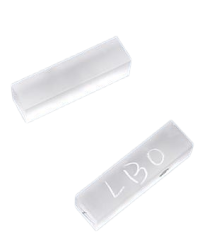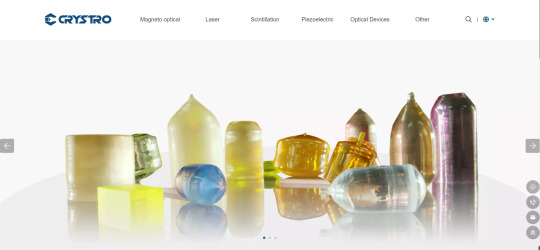Text
Exploring the Wonders of Nonlinear Crystals: A Complete Guide
Introduction
Nonlinear crystals are remarkable materials that play an essential role in various fields, including optics, electronics, and telecommunications. These unique crystals possess remarkable properties that allow them to convert photons into new wavelengths, making them invaluable in modern technologies. In this comprehensive guide, we will delve into the world of nonlinear crystals, exploring their characteristics, applications, and benefits.
What Are Nonlinear Crystals?
Nonlinear crystals are specific types of crystals that exhibit nonlinear optical properties. Unlike linear crystals, which respond linearly to light, nonlinear crystals respond exponentially. This ability allows them to generate new frequencies through the phenomenon known as second-harmonic generation (SHG) or frequency doubling. By producing wavelengths that are double or half the original input wavelength, it often enable scientists and engineers to manipulate light in exciting ways.
Characteristics of Nonlinear Crystals
Nonlinear crystals possess several key characteristics that make them highly valuable in various applications. Firstly, they have a high nonlinear coefficient, which determines the efficiency of the frequency conversion process. Crystals like lithium niobate (LiNbO3) and potassium titanyl phosphate (KTP) have exceptionally high nonlinear coefficients, making them popular choices for nonlinear optics research.
Secondly, these crystals exhibit a high damage threshold, allowing them to withstand intense laser beams without suffering significant degradation. This characteristic is crucial for applications involving high-power lasers such as medical devices, laser cutting, and telecommunications.
Thirdly, they can exhibit phase-matching properties, which ensure optimal conversion efficiency. Phase matching is achieved by adjusting crystal orientation, temperature, or using special coatings that compensate for the mismatch between the incoming and desired frequencies. Phase-matching techniques maximize the conversion efficiency and improve the overall performance of nonlinear devices.
Applications of Nonlinear Crystals
The unique properties of nonlinear crystals find applications in various fields. In telecommunications, they are used in wavelength conversion, allowing for the transmission of information over different optical channels. By converting light to different wavelengths, these crystals enable efficient signal processing and multiplexing.
Nonlinear crystals also serve a crucial role in laser technology. They are employed in harmonic generators, where high-power lasers are converted into shorter wavelengths for applications such as microscopy, spectroscopy, and laser machining. Additionally, they are used in optical parametric oscillators (OPOs) to generate tunable laser sources for scientific research and medical applications.
In quantum optics, nonlinear crystals facilitate the generation of entangled photons through a process called spontaneous parametric down-conversion (SPDC). These entangled photon pairs are essential for quantum communication, cryptography, and quantum computing.
In the field of biophotonics, nonlinear crystals contribute to advanced imaging techniques such as second-harmonic generation microscopy (SHG), coherent anti-Stokes Raman scattering (CARS), and multiphoton excitation fluorescence microscopy (MPEF). These imaging methods provide deep tissue imaging, label-free visualization of biomolecules, and high-resolution cellular imaging.
Benefits of Nonlinear Crystals
Nonlinear crystals offer several advantages that make them indispensable in various applications. Firstly, their ability to convert light to different wavelengths allows for flexible manipulation of light signals, enabling complex data transmission and advanced imaging techniques. This flexibility also facilitates compatibility with existing optical systems, making integration seamless and cost-effective.
Secondly, it exhibit excellent optical properties, including high transparency across a wide range of wavelengths. This enables efficient frequency conversion while maintaining the quality and integrity of the transmitted signals. Furthermore, their high damage threshold ensures reliable performance even under intense laser conditions.
Conclusion
Nonlinear crystals have revolutionized numerous fields by enabling efficient frequency conversion, advanced imaging techniques, and the development of cutting-edge technologies. Their unique properties and versatile applications make them indispensable in telecommunications, laser technology, quantum optics, and biophotonics. As research continues to explore the potential of them, we can expect even more exciting advancements in fields that rely on the manipulation of light. Incorporating these crystals into various technologies ensures advancements in data transmission, imaging capabilities, and overall performance, contributing to a brighter and more efficient future.

0 notes
Text
Harnessing the Power of Crystals: Unveiling the Relationship Between Crystals and Laser Technology
Introduction: Crystals have long astounded us with their captivating beauty and remarkable properties. From forming the foundation of gemstones to being used in various technological applications, crystals continue to amaze scientists, engineers, and enthusiasts around the world. In this article, we will explore the intriguing question: do crystals make lasers? Join us as we delve into the fascinating realm of crystal-powered laser technology.
Understanding Lasers: Lasers, short for Light Amplification by Stimulated Emission of Radiation, are sources of highly concentrated and coherent light beams. They find widespread applications in areas such as telecommunications, industry, medicine, and entertainment. But how are crystals related to this cutting-edge technology?
The Role of Crystals in Laser Development: Crystals play a crucial role in the creation, amplification, and manipulation of laser beams. Specifically, certain crystals possess unique optical, electrical, and thermal properties that make them ideal laser materials. These crystals are used in various laser components, including gain media, Q-switches, and frequency converters.
Laser Gain Media: Crystals act as gain media, the material responsible for amplifying light in a laser cavity. When properly excited, specific crystal structures emit light by stimulated emission, triggering a chain reaction that leads to the production of a coherent laser beam. Crystals like ruby, neodymium-doped yttrium aluminum garnet (Nd:YAG), and erbium-doped yttrium aluminum garnet (Er:YAG) are popular choices for laser gain media due to their ability to emit light at specific wavelengths.
Q-Switching: Crystal-based Control: Q-switches are devices that enable the generation of short and intense laser pulses. Crystals like potassium dihydrogen phosphate (KDP) or lithium niobate (LiNbO₃) are commonly used in Q-switches. These crystals have the unique property of being electro-optic, meaning they can control the passage of light pulses within the laser cavity. By manipulating the crystal's refractive index with an applied voltage, the Q-switch allows for precise control over laser pulses.
Frequency Conversion: Certain crystals possess the exceptional ability to convert laser light from one wavelength to another. This process, known as frequency conversion, is utilized to generate laser light at wavelengths that are not directly accessible with the laser's primary gain medium. Crystals such as potassium titanyl phosphate (KTP) and beta-barium borate (BBO) excel in frequency conversion by efficiently converting infrared light into visible or ultraviolet light.
Advancements and Emerging Crystal Technologies: Researchers are continuously exploring new crystal materials and techniques to enhance laser performance. For instance, rare-earth-doped crystals, including ytterbium-doped potassium gadolinium tungstate (Yb:KGW), have proven useful in high-power solid-state lasers. Additionally, efforts are underway to optimize crystal growth methods, improve crystal purity, and explore novel crystal compositions to overcome current limitations.
Conclusion: Crystals play a pivotal role in the creation and functionality of lasers. From serving as gain media for light amplification to controlling laser pulses and enabling frequency conversion, crystals are invaluable components in modern laser technology. As researchers and engineers continue to push the boundaries of crystal-based laser systems, we can expect further advancements that will revolutionize various industries and bring the magic of lasers to new heights.

0 notes
Text
How do laser crystals work?
Laser crystals are at the heart of laser systems, enabling the generation and amplification of coherent light. Understanding how laser crystals work requires a closer look at the underlying principles of stimulated emission and the process of lasing.
1. Stimulated Emission:
Laser crystals are typically composed of solid-state materials, such as ruby (chromium-doped aluminum oxide) or Nd:YAG (neodymium-doped yttrium aluminum garnet). These crystals contain dopant ions (e.g., chromium or neodymium) that have energy levels within the crystal lattice.
When the laser crystal is excited by an external energy source, such as a flashlamp or another laser, the dopant ions absorb energy and transition to higher energy levels. This process is called absorption. The excited ions then relax back to lower energy levels through spontaneous emission, releasing photons in random directions and phases.
However, in a laser crystal, a phenomenon called stimulated emission can occur. When a photon with a specific energy (matching the energy difference between the excited and lower energy levels) passes near an excited ion, it can stimulate the ion to release a second photon that is identical in energy, direction, phase, and polarization. This process creates a cascade effect, as the emitted photons can, in turn, stimulate other excited ions to emit more photons, resulting in the amplification of light.
2. Optical Resonator:
To achieve laser action, the laser crystal is placed within an optical resonator, which consists of two mirrors that form a cavity. One mirror is partially reflective, allowing a portion of the emitted light to escape, while the other mirror is highly reflective, reflecting the light back into the crystal.
The optical resonator plays a crucial role in the laser operation. It provides feedback to sustain the amplification process by reflecting the photons back into the crystal, which stimulates further emission and amplification. The length of the resonator determines the specific wavelengths of light that are amplified and emitted by the laser crystal.
3. Pumping Mechanism:
Laser crystals require an external energy source to excite the dopant ions and initiate the lasing process. This energy source is known as the pump. The pump can be in the form of flashlamps, diode lasers, or other lasers, depending on the specific crystal material and application.
The pump excites the dopant ions in the laser crystal, raising them to higher energy levels. As the ions relax back to their lower energy levels through stimulated emission, they emit photons that are amplified within the crystal due to the optical resonator. This amplification process continues until a sufficient number of photons are present in the resonator to form a coherent and intense laser beam.
In summary, laser crystals work by utilizing the principles of stimulated emission and optical resonators. The dopant ions within the crystal absorb energy from an external pump source, transition to higher energy levels, and then emit photons through stimulated emission. These photons are amplified within the crystal due to the optical resonator, resulting in the generation of a coherent and focused laser beam.

1 note
·
View note